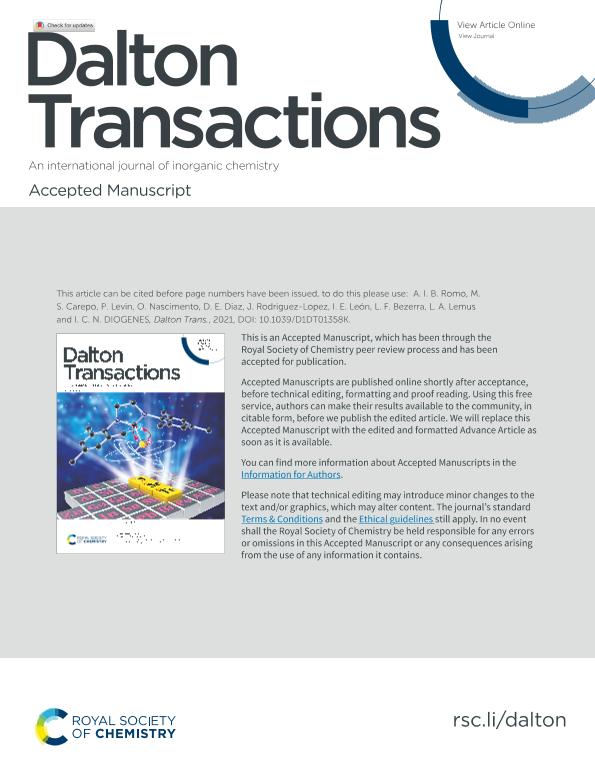Artículo
Synergy of DNA intercalation and catalytic activity of a copper complex towards improved polymerase inhibition and cancer cell cytotoxicity
Romo, Adolfo I. B.; Carepo, Marta P.; Levin, Pedro; Nascimento, Otaciro R.; Díaz, Daniel E.; Rodriguez Lopez, Joaquin; Leon, Ignacio Esteban ; Bezerra, Lucas F.; Lemus, Luis A.; Diógenes, Izaura C. N.
; Bezerra, Lucas F.; Lemus, Luis A.; Diógenes, Izaura C. N.
 ; Bezerra, Lucas F.; Lemus, Luis A.; Diógenes, Izaura C. N.
; Bezerra, Lucas F.; Lemus, Luis A.; Diógenes, Izaura C. N.
Fecha de publicación:
07/2021
Editorial:
Royal Society of Chemistry
Revista:
Dalton Transactions
ISSN:
1477-9226
Idioma:
Inglés
Tipo de recurso:
Artículo publicado
Clasificación temática:
Resumen
Improving the binding of metal complexes to DNA to boost cancer cell cytotoxicity requires fine tuning of their structural and chemical properties. Copper has been used as a metal center in compounds containing intercalating ligands due to its ability to catalytically generate reactive oxygen species (ROS), such as hydroxyl radicals (OH˙). We envision the synergy of DNA binding and ROS generation in proximity to target DNA as a powerful chemotherapy treatment. Here, we explore the use of [Cu(2CP-Bz-SMe)]2+(2CP-Bz-SMe = 1,3-bis(1,10-phenanthrolin-2-yloxy)-N-(4-(methylthio)benzylidene)propan-2-amine) for this purpose by characterizing its cytotoxicity, DNA binding, and ability to affect DNA replication through the polymerase chain reaction - PCR and nuclease assays. We determined the binding (Kb) and Stern-Volmer constants (KSV) for complex-DNA association of 5.8 ± 0.14 × 104and 1.64 (±0.08), respectively, through absorption titration and competitive fluorescence experiments. These values were superior to those of other Cu-complex intercalators. We hypothesize that the distorted trigonal bipyramidal geometry of [Cu(2CP-Bz-SMe)]2+allows the phenanthroline fragments to be better accommodated into the DNA double helix. Moreover, the aromaticity of these fragments increases the local hydrophobicity thus increasing the affinity for the hydrophobic domains of DNA. Nuclease assays in the presence of common reducing agents ascorbic acid, nicotinamide adenine dinucleotide, and glutathione showed the effective degradation of DNA due to thein situgeneration of OH˙. The [Cu(2CP-Bz-SMe)]2+complex showed cytotoxicity against the following human cancer cells lines A549, MCF-7, MDA-MB-231 and MG-63 with half maximal inhibitory concentration (IC50) values of 4.62 ± 0.48, 5.20 ± 0.76, 5.70 ± 0.42 and 2.88 ± 0.66 μM, respectively. These low values of IC50, which are promising if compared to that of cisplatin, are ascribed to the synergistic effect of ROS generation with the intercalation ability into the DNA minor grooves and blocking DNA replication. This study introduces new principles for synergizing the chemical and structural properties of intercalation compounds for improved drug-DNA interactions targeting cancer.
Archivos asociados
Licencia
Identificadores
Colecciones
Articulos(CEQUINOR)
Articulos de CENTRO DE QUIMICA INORGANICA "DR. PEDRO J. AYMONINO"
Articulos de CENTRO DE QUIMICA INORGANICA "DR. PEDRO J. AYMONINO"
Citación
Romo, Adolfo I. B.; Carepo, Marta P.; Levin, Pedro; Nascimento, Otaciro R.; Díaz, Daniel E.; et al.; Synergy of DNA intercalation and catalytic activity of a copper complex towards improved polymerase inhibition and cancer cell cytotoxicity; Royal Society of Chemistry; Dalton Transactions; 50; 34; 7-2021; 11931-11940
Compartir
Altmétricas



